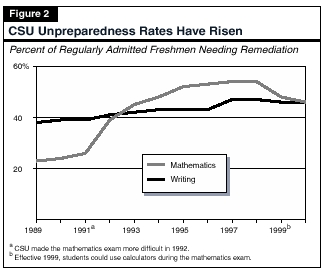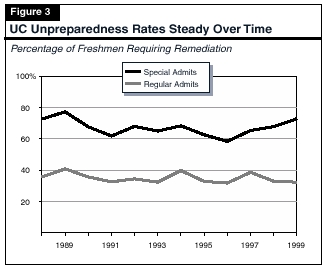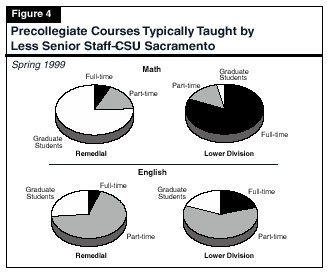Legislative Analyst's OfficeAnalysis of the 2001-02 Budget Bill |
Over the last several years, the Legislature has expressed considerable interest in improving high school students' academic preparation for higher education. Part of its interest stems from the persistently high proportion of college freshmen that arrive unprepared for college-level course work. In our recent report on precollegiate education in California (dated February 8, 2001), we identify options for enhancing students' academic preparation. In this section, we summarize our major findings and recommendations from that report. Specifically, we track over the last decade the proportion of students arriving at college unprepared. We then recommend options for both improving students' preparation and increasing universities' accountability for providing appropriate assistance to students who continue to arrive unprepared. In the next crosscutting issue, we discuss three budget proposals that significantly expand programs designed to improve students' academic preparation for higher education.
Although community college students do not have to demonstrate they are prepared for college-level work, both the California State University (CSU) and the University of California (UC) require students to demonstrate "college preparedness." Figure 1 shows the three ways students can demonstrate they are prepared for college-level work. First, if students score above a minimum level on the SAT, American College Testing Assessment (ACT), or Advanced Placement (AP) exams, then CSU and UC automatically consider them prepared for college-level work. Second, CSU and UC consider students prepared if they perform satisfactorily on entry-level college placement tests (which are developed by the universities). The UC administers the Universitywide Subject A Examination (to assess preparedness for college-level writing) whereas the CSU administers the English Placement Test (EPT) and the Entry-Level Mathematics (ELM) test. (Because mathematics is not required for UC's baccalaureate degree, it does not require students to demonstrate readiness for college-level mathematics.) If students do not score sufficiently high on either college admission or placement exams, they must enroll in and pass a precollegiate course.
|
Figure 1 |
|
|
Standards for Demonstrating College Preparedness |
|
|
Reading and Writing |
Math |
|
CCC |
|
|
None |
None |
|
CSU |
|
|
|
|
|
|
|
|
UC |
|
|
None |
|
|
|
|
Although the community colleges do not compile systemwide data on the level of proficiency of students entering their colleges, both CSU and UC report on the proportion of freshmen that arrive unprepared for college-level work. We tracked these "unpreparedness rates" over the last decade.
Almost Half of Regularly Admitted CSU Students Arrive Unprepared in Writing and Mathematics. Figure 2 shows the CSU systemwide unpreparedness rate in writing and mathematics for regularly admitted freshmen over the last decade. In fall 1989, 38 percent of regularly admitted freshmen were unprepared for college-level writing and 23 percent were unprepared for college-level mathematics. By fall 2000, the unpreparedness rate in writing had increased by more than one-fifth—to 46 percent. The unpreparedness rate in mathematics also increased sharply between 1989 and 1998—when 54 percent of regularly admitted freshmen arrived unprepared. For the last two years, however, the unpreparedness rate in mathematics has fallen—dropping to 45 percent in fall 2000.

Almost All Specially Admitted CSU Students Arrive Unprepared. In 1999-00, almost 10 percent of CSU freshmen were specially admitted, meaning they either had not yet completed the 15 required college preparatory courses or they had failed to obtain a sufficiently high grade point average or SAT score. Although CSU does not report the proportion of specially admitted students that is unprepared for college-level writing and mathematics, it states that almost all these students are likely to be unprepared. Data provided by CSU Sacramento support this assertion. In fall 1998, 17 percent of freshmen were specially admitted. Of these students, 91 percent were unprepared for college-level writing.
Unpreparedness Has Remained Relatively Constant at UC. Figure 3 shows the UC systemwide unpreparedness rate in writing for regularly and specially admitted freshmen over the last decade. In fall 1988, 35 percent of regular admits and 74 percent of special admits were unprepared for college-level writing. By fall 1999, these percentages had changed only slightly—to 32 percent and 73 percent, respectively. (During these years, approximately 5 percent of all freshmen were specially admitted.)

We recommend the community colleges, the California State University, and the University of California work with high schools to develop methods to diagnose readiness for college-level work while students are still in high school.
The college faculty we interviewed emphasized the importance of assessing all prospective students and assessing them as early as possible. Unfortunately, all CSU and UC students who do not score sufficiently high on college entrance exams must wait until they have been admitted to a campus before they can take placement tests to determine if they can enroll directly in college-level writing and mathematics courses. Similar to these aspiring university students, community college students often do not know they are unprepared unless they take a community college placement exam or until they actually enroll in a college-level course and discover they are unable to meet its demands.
Current Process Poorly Serves Students. The current assessment process—which informs many students of their skill deficiencies only after they have been admitted to college—often results in students paying higher college costs and taking longer to graduate. Freshmen who are deemed unprepared must enroll in at least one (and often two or three) precollegiate courses—which typically do not apply toward one's baccalaureate degree. Students attending CSU and UC pay the same fee for precollegiate courses as for all other college-level courses. They do so even though they could have taken each precollegiate course at a community college for approximately $30 or during high school at no charge. Moreover, having to take these additional courses in college can prolong a student's time to degree. In short, the current system costs students both time and money.
Two Options for Assessing Earlier. The segments have two basic options for assessing students earlier. They can either use high school assessment tests to determine college readiness or they can offer their own assessment tests to high school students. Under the first option, the segments would use one or more existing high school assessments (such as the augmented Standardized Testing and Reporting exam, Golden State exams, Advanced Placement exams, SAT I and SAT II, or the new high school exit exam) to determine students' readiness for college-level work. Under the second option, the segments would allow aspiring college students to take the Subject A, EPT, ELM, and other community college placement tests while they are still in high school. Either option would help students identify their level of college readiness earlier, thereby providing them more options in seeking additional academic assistance—options that might save them time and money. (In the next section of the Analysis, we discuss a new program—the Diagnostic Writing Service—which allows high school students to take CSU's and UC's placement exams online.)
Once students have been assessed and deemed unprepared, the higher education segments employ a variety of strategies to help them overcome their skill deficiencies. The community colleges offer both noncredit precollegiate courses—that primarily serve students who have not yet graduated from high school or who have special educational needs—and credit precollegiate courses—that primarily serve students who desire to transition into transferable college courses. The CSU offers several nondegree-applicable precollegiate courses. Most of these courses are traditional, term-length classes taught by CSU instructors. Several CSU campuses, however, now also offer short workshops and computer-mediated courses for students whose skill deficiencies are less severe. Like CSU, UC offers primarily term-length, nondegree-applicable precollegiate courses. Several campuses, however, offer intensive six-unit degree-credit courses that incorporate precollegiate and college-level material. Additionally, both CSU and UC use community college faculty to teach some of their precollegiate courses. (These courses are held on the CSU or UC campus.)
Although all higher education segments offer precollegiate services, the state has yet to hold them accountable for providing high quality, cost-effective services. Currently, because of the lack of rigorous post-assessment procedures and the inadequacy of reporting requirements, neither the Legislature nor the public can easily or meaningfully evaluate if the segments help unprepared students obtain the skills they need to succeed academically during the remainder of their college experiences. Furthermore, because of the inconsistency of the state's precollegiate funding policies, the Legislature cannot hold the segments accountable for providing cost-effective precollegiate services.
We recommend the Legislature require the community colleges, the California State University, and the University of California to assess and annually report on the reading, writing, and mathematics proficiency of all entering students—including transfer students.
If the Legislature and the public are to hold the three segments accountable for providing high-quality precollegiate services, they must first obtain basic information regarding the nature and magnitude of entering students' unpreparedness. Although this information is crucial to the Legislature's ability to ensure accountability, UC is the only higher education segment that has historically assessed and reported on the preparedness of all entering students. To improve the availability and quality of information on unpreparedness, we recommend:
If the community colleges, CSU, and UC routinely provided this assessment information to the Legislature, it would be much better informed as to the quality of services students are receiving across the K-16 educational spectrum. It would then be better equipped to determine the most appropriate way to hold public schools and universities accountable for improving student achievement.
We recommend the Legislature require the community colleges, the California State University, and the University of California to assess and routinely report on the effectiveness of their precollegiate services.
None of the three segments currently requires students to pass a standardized proficiency exam upon completion of a precollegiate course. Furthermore, none tracks the future academic success of initially unprepared students. This means the segments cannot evaluate the merits of any of the various precollegiate services they provide. We therefore recommend that the segments:
|
The CSU's New Disenrollment Policy In fall 1998, the Chancellor's Office issued Executive Order 665, which requires campuses to disenroll students who do not complete precollegiate courses within a specified amount of time. (The new policy therefore holds students accountable for their performance, but it does not directly address the issue of institutional accountability.) Specific campus policies vary, but most campuses now require students to complete their precollegiate coursework in 12 months to 15 months after initially enrolling on campus. Of the regularly admitted students who entered in fall 1998 needing additional precollegiate coursework, approximately 20 percent had not completed it by fall 1999. Although campuses are to disenroll these students based on the new policy, actual campus practices vary greatly. Whereas the Maritime Academy disenrolled all students not completing their precollegiate coursework within the allotted time, CSU Stanislaus allowed 60 percent of these students to remain on campus. |
State Should Offer Only One Precollegiate Funding Rate
We recommend the state fund the California State University's and the University of California's precollegiate writing and mathematics courses at the same rate it funds credit courses at the community colleges.
The state currently funds precollegiate services at the three segments in widely disparate ways. At the community colleges, the state provides $3,492 (1999-00 rate) per full-time equivalent (FTE) student for all credit courses regardless of whether they are precollegiate or college-level courses. Similarly, the state provides CSU with $6,360 (2001-02 rate) per FTE student for all credit courses regardless of whether they are precollegiate or college-level courses. In contrast, the state does not fund precollegiate courses at UC (unless a campus offers the course for degree-credit). The state therefore provides UC with $9,158 (2001-02 rate) per FTE student for its college-level courses but zero dollars for its precollegiate courses.
Disparate Rates Generate Wrong Incentives. By providing CSU with the same level of funding for unprepared and prepared students, state policy encourages CSU to admit students regardless of their level of academic preparation. If the state funded CSU precollegiate courses at the community college rate, it would reduce this incentive (though it would not disallow CSU from accepting and enrolling all students it believed could succeed). In contrast, by not providing UC with any funding for its precollegiate courses, state policy encourages UC to reserve "precollegiate" courses for only the most challenged students. For example, UC Riverside allows only nonnative English speakers to enroll in specialized precollegiate writing courses. All other students who have not yet passed the Subject A exam must enroll directly in regular lower division courses. Because UC does not characterize these courses as precollegiate, it receives full funding for these courses, and the courses are not specialized to help unprepared students overcome their skill deficiencies.
Precollegiate Courses Likely Cost Less Than College-Level Courses. Evidence suggests that precollegiate courses are likely to cost less than college-level courses. Figure 4 shows, for example, that CSU Sacramento uses disproportionately more graduate students and part-time instructors for precollegiate courses than for regular lower division courses. These courses therefore are likely to be comparable in cost (or might even be less costly) than community college courses.
Offer One Precollegiate Rate. Funding all precollegiate courses at the rate the state currently funds community colleges would have three significant benefits. It would provide financial incentives for CSU to reconsider the most efficient and effective way to deliver precollegiate services. It would encourage UC to tailor precollegiate services to the special needs of unprepared students. It would also motivate CSU and UC to expand their collaborations with community colleges for delivery of precollegiate services. Several CSU campuses and two UC campuses currently contract with community college faculty to teach precollegiate courses on the university campuses. Both CSU and UC have indicated that these collaborations are successful.

In conclusion, many students are currently arriving at community colleges, CSU, and UC lacking the academic preparation necessary to engage successfully in college-level courses. To improve students' academic preparation for college and increase the segments' accountability for appropriately serving unprepared students, we recommend the segments assess students' college readiness earlier, report on the preparedness of all entering students, and study the effectiveness of their precollegiate services. Furthermore, we recommend the Legislature fund precollegiate courses across the three segments in a more equitable manner.